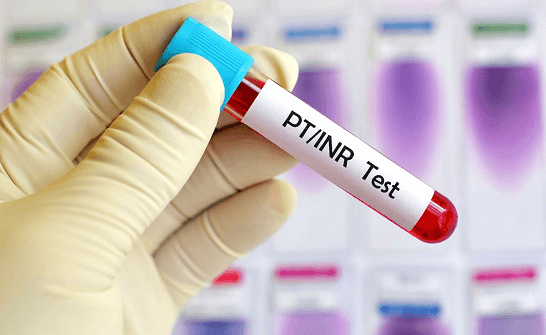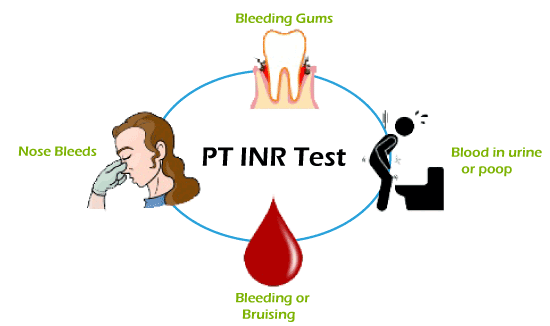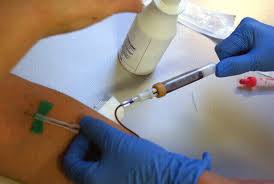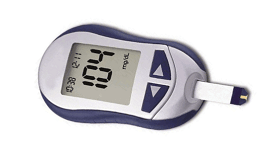What is INR?The international normalized ratio (INR) is a standardized number that is figured out in the lab. If you take blood thinners or anti-clotting medicines, or anticoagulants, it may be essential to check your INR. The INR is measured using the results of the prothrombin time (PT) test. This test measures how much time it takes for your blood to clot and determines if you're receiving the correct dose of warfarin. The INR is an international standard for the PT. An INR is a type of calculation based on PT test results. Prothrombin is a protein made by the liver. It is one of several substances known as clotting factors. When you get a cut or other injury that causes bleeding, your clotting factors work together to form a blood clot. Clotting factor levels that are too low can cause you to bleed too much after an injury. Levels that are too high can cause dangerous clots to form in your arteries or veins. 
A PT/INR test helps find out if your blood is clotting normally. It also checks to see if the medicine that prevents blood clots is working the way it should. For example, if your INR is too low, you could be at risk for a blood clot, but if it's too high, you could experience bleeding. A typical INR target ranges from 2-3 but can vary from patient to patient. For example, patients with a tendency towards clotting may have a range targeting 3-4, whereas patients with a higher bleeding risk may have a lower INR between 2-2.5. How to Measure the INR?PT was initially expressed as a PT of a control value ratio to overcome the variability between laboratories. The control value was the average of prothrombin times from 20 or more healthy subjects. While expressing PT compared to a control value was seen as an improvement, it was still insufficient. So in 1983, the international sensitivity index (ISI) was applied to this ratio to derive the INR: INR = (PTtest / PTnormal)ISI
The ISI is a numerical value representing the responsiveness of any given commercial system relative to the international standard. It takes into account the variability in results obtained using different commercial systems in calculating the result. In this way, results from different laboratories and countries can be compared more readily. Uses of PT/INR TestA PT/INR test is most often used to:
A PT/INR test is often done along with a partial thromboplastin time (PTT) test. A PTT test also checks for clotting problems. Who Need PT/INR Test?PT/INR test needs depend on how stable a patient's INR is over time. According to the American Heart Association (AHA), patients should be tested at least once a month, but some patients will require testing as often as twice a week. INR tests can do at a lab or clinic and home for some patients. Home testing requires the use of an in-home INR monitoring machine and test strips. After self-testing with this device, you can report your INR results to your care team to determine if you need to adjust your warfarin dose. 
And patients may need this test if they have symptoms of a bleeding or clotting disorder. Symptoms of a bleeding disorder include:
And symptoms of a clotting disorder include:
In addition, you may need a PT/INR test if you are scheduled for surgery. It helps make sure your blood is clotting normally, so you won't lose too much blood during the procedure. Why do we Monitor INR?We regularly monitor the INR of people using warfarin to balance the risk of excessive bleeding against the risk of clotting or thrombosis. When the INR is too high, the blood is too thin, and the INR is too low, or the blood is too thick. INR values over 4.5 increase the risk of significant hemorrhage (bleeding). An INR of less than 2 increases the risk of thromboembolism (formation of blood clots within the blood vessels) and associated conditions such as heart attack and stroke. Regular monitoring is important with a drug such as warfarin because:
Evidence suggests that more frequent testing will result in more time within the desired INR target range. For example, studies suggest that the desired results are achieved 50% of the time with monthly monitoring, compared to 85% with weekly monitoring. What can interfere with the INR?Many medications, foods, and concurrent illnesses interact with warfarin, therefore interfering with the INR. These affect the way the body processes warfarin. Therefore, you should consult your doctor if:
Common medications that interfere with warfarin include:
What should the INR be?The desired INR depends on the reason why you need anticoagulation. The three most common reasons for warfarin use, along with their target INRs, include:
How is INR tested?INR can be monitored either by laboratory blood testing or by using a portable monitoring device. 1. Laboratory testing In laboratory blood testing, blood is drawn from a vein, typically by a GP, and sent to the laboratory for testing. There is a time delay before results are returned to the GP, who analyses the need for dose adjustment with the help of computerized algorithms. 
The practitioner will then let you know whether a dose adjustment is needed. A dose adjustment will require if your INR value for the test is outside the therapeutic range. In a test tube during a laboratory test, two "pathways" can initiate clotting, the so-called extrinsic and intrinsic pathways. Both of these then merge into a common pathway to complete the clotting process.
2. Testing using a portable device Portable devices allow you, your doctor, or another health practitioner to obtain blood test results on the spot, using a drop of fingertip blood as the sample. The blood drop is placed on a test strip inserted into the portable device to measure the clotting time. The result as an INR value is then displayed on the device's screen. 
These devices have been demonstrated accurate and reliable and provide reproducible results similar to those obtained through laboratory testing.
Next TopicTypes of Layouts
|
 For Videos Join Our Youtube Channel: Join Now
For Videos Join Our Youtube Channel: Join Now
Feedback
- Send your Feedback to [email protected]
Help Others, Please Share










